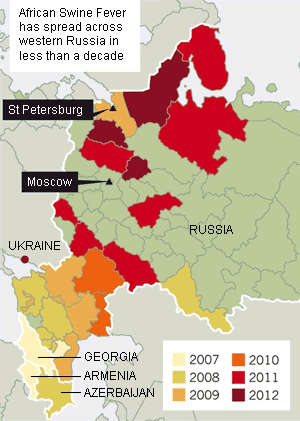Scientists first encountered African swine fever in the 1920s in domestic pigs in Kenya, where the vicious haemorrhagic fever felled nearly every animal infected. The virus, which is also carried by warthogs and ticks without causing disease, is now endemic in much of sub-Saharan Africa, limiting pig farming there. It does not infect humans.
 In 1957, the virus jumped to Portugal after pigs near Lisbon’s airport were fed infected human food scraps (the virus particles can survive meat curing processes). It then hit Spain, and import of the region’s ham — including the coveted jamón ibérico — was banned by many countries, until the disease was eradicated in Spain and Portugal in the mid-1990s.
In 1957, the virus jumped to Portugal after pigs near Lisbon’s airport were fed infected human food scraps (the virus particles can survive meat curing processes). It then hit Spain, and import of the region’s ham — including the coveted jamón ibérico — was banned by many countries, until the disease was eradicated in Spain and Portugal in the mid-1990s.

The cases now flaring up in Russia, Ukraine and other countries in the Caucasus have their origins in a 2007 outbreak in the former Soviet republic of Georgia, where the virus gained a foothold after being imported from Africa. The disease quickly jumped to neighbouring Azerbaijan, Armenia and Chechnya, before fanning out across Russia.
To the east, the disease has been detected on the doorstep of Kazakhstan, which shares a long border with China, home to more than 1 billion pigs. China also risks importing the virus through its growing trade with African nations.
Europe’s large pig farms are buffered by better biosecurity and hygiene practices. But agencies such as the UK Department of Environment, Food and Rural Affairs in London are nevertheless watching the situation closely.
August 28, 2012 - Nature 488, 565–566 (30 August 2012) doi:10.1038/488565a




